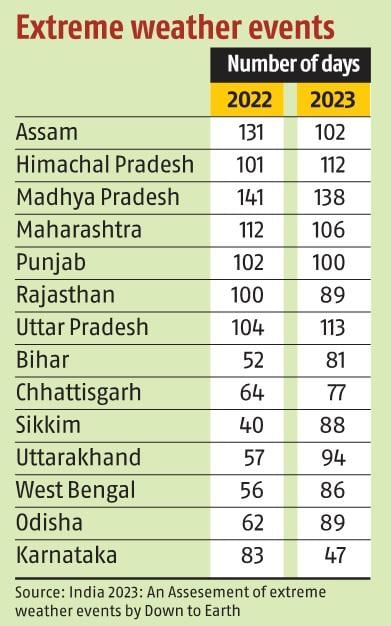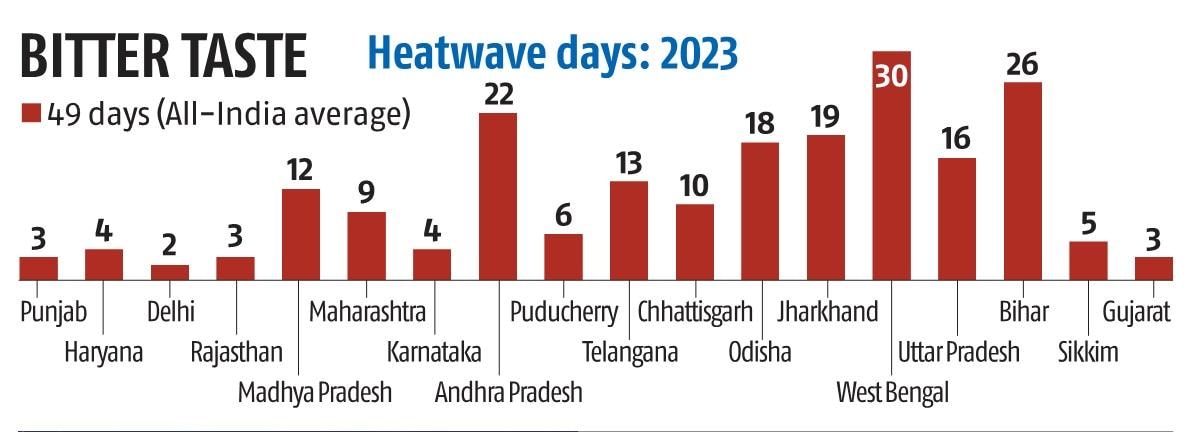Despite the good news of a normal monsoon this year, all forecasts carry a similar warning: It’s going to be a harsh summer.
The India Meteorological Department (IMD) said there will be more than 10 to 20 extreme heat wave days between April and June, double the number last year. Mercury’s maximum and minimum temperatures are expected to reach new highs, which scientists believe will push the limits of human survival.
In addition to the human body, human food will also be directly affected. From staples like wheat to coffee, dairy products and even the great hilsa are facing the threat of dwindling supplies due to the intense heat.
This year, however, wheat, one of the main cereals grown during the Rabi season, has escaped the heat of summer as most of the crop has already been harvested or is in the growing stage and the heat has little impact on yields.
But the fear remains.
Due to the heat wave, your vegetarian and non-vegetarian thali will not only cost more but also taste different. In addition, the market expects price increases and changes in existing supply chains.
Wheat is most vulnerable to extreme hot weather in parts of India starting in March. Vegetables are a close second.
India is the world’s second largest producer and consumer of wheat.
Recent research from the nonprofit Uncharted Waters, which has collected 30 years of data, suggests that cold winters and subsequent hot springs can reduce wheat yields in important growing areas by about 20 percent. This is a much lower reduction than in years with consistently hot or cold weather.
The paper concluded that this could lead to a 5% to 10% reduction in overall wheat production. Wheat is grown in winter and harvested in late spring to avoid high temperatures affecting grain filling and inhibiting yields. If planting is late, or growth is slow due to cooler than average temperatures, the summer heat can cause serious damage to crops if it arrives early.
This is exactly what is happening in India. A new study in Climate Trends finds that the likelihood of dangerously hot weather in late March and early April has increased significantly compared with the 1970s. This roughly means that spring is shortened and summer comes earlier and lasts longer.
The glimmer of hope is that this year’s wheat crops are in the grain-filling and maturity stage in most areas and temperatures are beginning to rise. Even if daytime temperatures in some areas exceed 37 degrees Celsius, yields have not been affected.
But it’s not just about the heat; Unseasonal rainfall and hail are also a direct consequence of global warming and pose a threat. There have been reports of rain, lightning and even hail flooding fields.
Boiling supply chain
As mercury levels increase, so does the potential for spoilage. Low levels of adequate refrigeration and freezing facilities leave fruits and vegetables vulnerable to heat damage. Milk supplies are falling faster than expected due to hot weather. As supplies of fresh liquid milk fall abnormally, reliance on stored skimmed milk powder (SMP) increases.
Milk supplies will fall anyway starting in March as less water is available for cattle and the dairy industry relies on stocks of skimmed milk powder to meet regular demand. However, during extreme heat, even these limited supplies can suffer as fresh feed becomes scarce.

Fish are not spared either. The United Nations Intergovernmental Panel on Climate Change (IPCC) said in its assessment report that production of commercial fish such as anchovies and Bombay duck will decline and agricultural labor capacity will decline due to the adverse effects of climate change.
Your morning cup of tea isn’t safe either. Due to strong demand and reduced supply, Indian robusta coffee prices have hit an all-time high of over Rs 10,000 per 50 kg bag. Typically, the price of Robusta per 5 kg bag ranges between Rs 2,500 to Rs 3,500. This year, production has been affected by uneven rainfall, drought and a heat wave caused by El Niño. Indian markets rallied on expectations of rising demand amid tight global supplies. India is the sixth largest coffee producer in the world, with Brazil topping the list.
Reimagining agriculture
Experts say climate change will exacerbate soaring food crop prices in India, ultimately leading to severe economic and social vulnerability.
The price of a typical basket of food products almost tripled between May and June last year, according to an analysis of climate trends. IPCC analysis said that in the long term, rice, wheat, pulses, coarse grains and cereal production may decline by nearly 9% by 2050.
The disruption to crop production is expected to cause prices to surge in India, threatening food affordability, food security and economic growth, the IPCC said.
Supply chains need to be recalibrated as extreme weather events can cause companies to change procurement plans and strategies and adopt sustainable sourcing methods.
The likelihood of extreme weather events such as heat waves in 2022 is now 30 times greater, affecting crops such as wheat, corn and soybeans. The consequences ripple across every aspect of Indian life, from 153 billion working hours lost globally in 2017 (mainly in agriculture) to 90% of India being at high risk of climate-induced heat waves, endangering food security and sustainable development goals, Anjal Prakash, clinical associate professor (research) and director of research at the Bharti Institute of Public Policy at the Indian School of Business, is also one of the authors of the above-mentioned IPCC report.
Prakash believes that as the climate crisis intensifies, crop diversification and resilient farming practices will help weather the storm and ensure a sustainable future.
The federal government is developing mechanisms and grassroots programs to establish climate-resilient agriculture. National Mission on Permaculture (NMSA) is one of the eight missions under India’s National Action Plan on Climate Change. The Ministry of Agriculture said in Parliament in August last year that between 2014-23, NMSA has developed 1,888 climate-resilient crop varieties and 68 climate-resilient technologies have been demonstrated in 15,857 farmland plots in 454 villages.
During India’s G20 Presidency, member states are committed to accelerating innovation and investment, with a focus on increasing agricultural productivity, reducing food loss and waste across the value chain, and improving marketing and storage to build a more sustainable and climate-resilient agriculture and food systems. These promised results need to be delivered before the twin crises of inflation and global warming hit us hard.
#Climate #crisis #meals #expensive #thaali #catch #fire
Image Source : www.business-standard.com
